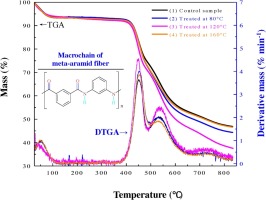Journal of CO2 Utilization ( IF 7.7 ) Pub Date : 2019-12-11 , DOI: 10.1016/j.jcou.2019.10.007 Cong Zhang , Yao-Xing Jiang , Jian-Ping Sun , Hong Xiao , Mei-Wu Shi , Jia-Jie Long

|
Influence of supercritical carbon dioxide (SCF-CO2) on the thermal decomposition behavior and kinetics of meta-aramid fiber was investigated at the first time, in order to develop some fundamental bases for sustainably and cleanly manufacturing some relative products from this fiber with the supercritical green medium. Particularly, the thermal decomposition behavior of treated samples was explored and characterized by thermogravimetric and differential thermogravimetric analysis (TGA-DTGA). The kinetics of the main steps of thermal decomposition was also investigated via different kinetics models. The results show that an influence of SCF-CO2 treatment on the thermal decomposition behavior of the fiber was observed by TGA-DTGA, accompanied with successive and partially overlapped predominant two-step degradation as sample temperature from 380.0 °C to 700.0 °C, as well as a small pyrolysis Step three at 650.0 °C to 800.0 °C. Decreases in thermal property and behavior were detected by TGA-DTGA for the samples as treatment temperature from 80.0 °C to 120.0 °C. The fitted results reveal that good linear regressions of the TGA-DTGA data were achieved from the kinetics models accompanied with high values of adjusted R-Square. The kinetics parameter of the apparent activation energy (E) decreased with the treatment temperature from 80.0 °C to 120.0 °C, as well as with the conversion degree (α) of the samples. Moreover, a second-order chemical reaction mechanism for the predominant thermal decomposition steps was successfully supposed by Coats-Redfern and Achar-Brindley-Sharp-Wendworth models combined with a solid mechanism function of C2.
中文翻译:

超临界二氧化碳处理对间位芳纶纤维的影响:热分解行为和动力学
首次研究了超临界二氧化碳(SCF-CO 2)对间位芳族聚酰胺纤维的热分解行为和动力学的影响,以期开发出一些基础材料,以可持续,清洁地从该纤维制造相关产品。超临界绿色介质。特别是,通过热重分析和差示热重分析(TGA-DTGA)探索并表征了处理后样品的热分解行为。还通过不同的动力学模型研究了热分解主要步骤的动力学。结果表明,SCF-CO 2的影响TGA-DTGA对纤维的热分解行为进行了处理,伴随着样品温度从380.0°C到700.0°C的连续和部分重叠的主要两步降解,以及650.0°的小热解步骤到800.0°C。通过TGA-DTGA检测到样品的热性质和性能下降,处理温度为80.0°C至120.0°C。拟合结果表明,从动力学模型获得了良好的线性回归的TGA-DTGA数据,同时具有较高的R-Square调整值。表观活化能(E)的动力学参数随着处理温度从80.0°C降低到120.0°C以及转化率(α)的样本。此外,Coats-Redfern模型和Achar-Brindley-Sharp-Wendworth模型结合了C2的可靠机理,成功地假设了主要热分解步骤的二级化学反应机理。


























 京公网安备 11010802027423号
京公网安备 11010802027423号